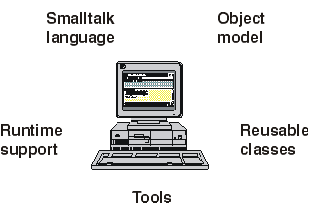The basic development environment

VA Smalltalk enables you to rapidly build products in the Smalltalk language. The VA Smalltalk basic development environment consists of the following areas:
•The Smalltalk language.
•An object model. Smalltalk provides a model of how objects are defined and how they behave. This object model supports inheritance, class and instance behavior, dynamic binding, messaging, and memory management (including garbage collection).
•A set of reusable classes. The development environment offers an abundant set of classes that you can reuse in your Smalltalk programs. These classes provide the basic functions in Smalltalk. They support cross-platform portability, including portable graphical user interfaces. They also support the definition and management of classes.
•A runtime environment. Smalltalk provides runtime support that complements its object model. The runtime environment supports creating class instances, message routing, and automatic memory management, including garbage collection and dynamic binding. With Smalltalk, you no longer adhere to the traditional compile-link-run cycle. Instead, you can run and test your Smalltalk programs while you change the source code. Changes to the source code are instantly reflected in the running program!
•A set of development tools. The development environment provides tools that enable you to create, view, and change classes. Additional tools let you inspect and debug source code. Other tools analyze your code for performance. And, when your program is ready to ship, the packaging tools produce a runtime image for distribution.
Last modified date: 07/22/2020